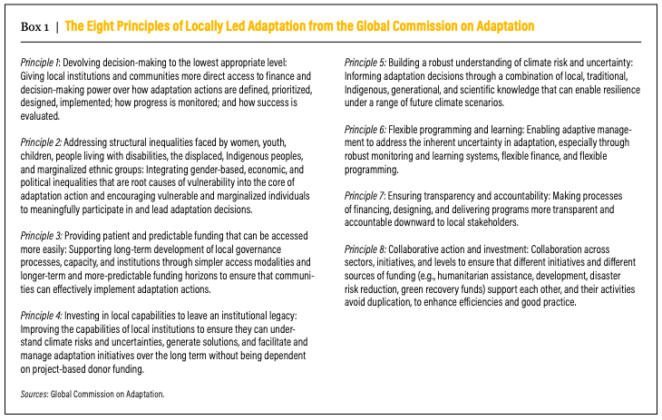Locally Led Adaptation: From Principles to Practice

Introduction
As funders and national governments invest in building resilience to climate impacts, many are recognizing the value of locally led adaptation (LLA) to manage climate risks faced by local communities and Indigenous peoples. As of May 2022, more than 70 organizations and governments had endorsed eight Principles for Locally Led Adaptation.
Locally led adaptation is distinct from consultative, participatory, inclusive, and many community-based approaches to adaptation in that it gives local actors agency over adaptation, rather than merely allowing their participation in processes around adaptation. Locally led action can address historical imbalances of power and disproportionate vulnerabilities that climate change will otherwise deepen. LLA requires governance and financing processes that prioritize the agency of local actors that are on the front lines of climate change impacts and are often best placed to identify adaptation solutions.
This paper contributes to the growing evidence base on LLA and encourages continued learning from local practice and expertise. It provides 21 examples of approaches to investing in and implementing LLA to demystify the steps funders and governments can take to operationalize and scale adaptation in line with the Principles for Locally Led Adaptation. Funders, governments, and other relevant actors can draw on these approaches to turn investments in and commitments to LLA into new policies, practices, and actions that ensure local partners have equitable access to climate finance and are at the centre of decision-making processes.
This paper was co-developed by a consortium of partners working together to deliver the Adaptation Action Coalition’s Locally Led Adaptation Workstream.
This weADAPT article is an abridged version of the original text, which can be downloaded from the right-hand column. Please access the original text for more detail, research purposes, full references, or to quote text.

Methods and Limitations
The observations presented in this paper were derived from a selection of 21 examples of locally led adaptation, which were prepared by the implementing organizations and their partners. These examples were initially collected to inform a regional dialogue series on scaling locally led adaptation, which was held between September and October 2021.
The methodology entailed four steps: selecting examples of LLA efforts for inclusion; documenting and analyzing qualitative information on each of the examples; validating this information with experts directly involved in the examples; and reviewing approaches and learnings about LLA implementation. The analytical framework used the Principles for LLA and analysis of aspects of locally led adaptation by Tye and Suarez (2021), and included elements like quality of finance, integration of local knowledge, and degree of local ownership.
The paper’s findings and recommendations were shaped by the small sample size and the limited extent of documented data for these examples. It therefore provides an overview of a wide range of approaches from different contexts, rather than an in-depth analysis of a few approaches.
Refer to the methods section of the paper to explore the selection criteria for the discussed examples.
Mechanisms and Approaches for Advancing Locally Led Adaptation
The examples highlighted in this paper illustrate that there are many proven ways that adaptation finance can reach local actors and ensure they have agency, depending on the context and type of organization, and that there are many opportunities available to funders and governments to adapt and scale LLA approaches. These include leveraging existing finance and governance models, and building in practical steps and considerations for procurement, capacity building, monitoring, and other processes. Opportunities are found in mechanisms such as grants facilities, loan funds, savings schemes, microfinance, national planning policies, domestic finance programs, community-led emergency response and early warning systems, and social protection schemes. The examples reviewed for this paper show that approaches to advancing LLA often address discrete elements of LLA, but these are interconnected. They also underscore the importance of deliberately addressing structural inequalities and disproportionate climate vulnerabilities and reveal priority areas for future research.
These examples fall into several broad categories: intermediary-managed funds, funds accessed by grassroots organizations, government-managed funds, and private foundations. Examples within each category illustrate the approaches to governing finance for LLA, which offer different advantages. These categories are not mutually exclusive, and some examples align with more than one category.
Access the full paper to explore the role of global organisations, as well as examples of initiatives from Africa, Asia-Pacific, and Latin America and the Caribbean, in advancing LLA. These examples show the diversity of approaches being used to put LLA principles into practice.
Conclusion and Recommendations
Local communities and institutions are at the front lines of climate change impacts and offer valuable expertise and innovative solutions to address the climate crisis. Yet the prevailing systems for finance and governance of adaptation interventions are not structured to ensure agency or deliver adequate resources for local actors to adapt to climate impacts.
The 21 examples of investing in and implementing LLA described in this paper highlight many approaches across a range of sectors and geographic and sociocultural contexts. Taken together, they lead to the following recommended strategies for how to advance LLA. These proposals apply to all institutions committed to implementing LLA, but they are most relevant to funders and governments:
- Pursue opportunities to scale LLA by increasing the amount of climate finance allocated to it, improving the quality of finance by making it more accessible and flexible, and adjusting governance and decision-making processes to ensure that local actors have agency in adaptation planning and implementation.
- Address the Principles for LLA holistically so that adaptation investments, policies, and interventions enable and scale LLA in multiple ways simultaneously.
- Advance active learning and research on LLA processes, outcomes, and impacts to continue to fill knowledge and evidence gaps and improve collective understanding of good practices for equitable and effective LLA.
- Integrate social equity in LLA efforts, including by building such considerations into standard processes and decisions, and investing in mechanisms specifically designed to support groups that experience disproportional vulnerabilities.
These success stories of putting the Principles for LLA into practice can serve as a rallying cry for speeding up and scaling locally led adaptation action to better address the growing urgency of the mounting climate emergency.
Suggested Citation:
Coger, T., Dinshaw, A., Tye, S., Kratzer, B., Thazin Aung, M., Cunningham, E., Ramkissoon, C., Gupta, S., Bodrud-Doza, Md., Karamallis, A., Mbewe, S., Granderson, A., Dolcemascolo, G., Tewary, A., Mirza, A. and Carthy, A. (2022). Locally Led Adaptation: From Principles to Practice. Working Paper. Washington, DC: World Resources Institute. Available online at https://doi.org/10.46830/wriwp.21.00142.
(0) Comments
There is no content